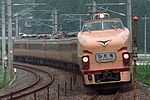213 series
From Wikipedia, the free encyclopedia
| 213 series | |
|---|---|
 JR West 213-0 series | |
| In service | 1987–Present |
| Manufacturer | Hitachi, Kawasaki Heavy Industries, Kinki Sharyo, Nippon Sharyo, Tokyu Car Corporation |
| Constructed | 1987–1991 |
| Operator |
JNR (1987) JR West (1987–Present) JR Central (1989–Present) |
| Specifications | |
| Car body construction |
Stainless steel Steel (KuRo 212) |
| Car length | 20,000 mm (65 ft 7 in) |
| Width | 2,950 mm (9 ft 8 in) |
| Doors | 2 pairs per side |
| Maximum speed |
110 km/h (70 mph) 130 km/h (80 mph)(U@tech) |
| Traction system | Resistor control + field system superimposed field excitation control |
| Electric system(s) | 1,500 V DC |
| Current collection method | overhead catenary |
| Bogies |
DT50B(powered car),TR235B(trailer car)(213-0 series) WTR235(KuRo 212) WTR235BX(SaYa 213) WTR235XB(KuYa 212) C-DT56(powered car),C-TR241(trailer car)(213-5000 series) |
| Safety system(s) | ATS-SW (213-0 series), ATS-ST (213-5000 series), ATS-P (213-0 series(U@tech)) |
| Multiple working |
313 series 223 series (U@tech) |
| Track gauge | 1,067 mm (3 ft 6 in) |
The 213 series (213系) is a suburban electric multiple unit (EMU) train type introduced in March 1987 by Japanese National Railways (JNR), and currently operated by West Japan Railway Company (JR West) and Central Japan Railway Company (JR Central) in Japan. It is based on the previous 211 series, although it differs in having four side doors per car instead of six.
From 1988 to 2003, the JR West sets were mainly used for the Marine Liner service connecting Okayama and Takamatsu via the Great Seto Bridge. These trains sometimes used a panoramic cab car (numbered KuRo 212), the latter was scrapped in 2008.
-

KuRo 212 panoramic coach, 1988
Formations
JR West
3-car sets
| Car No. | 1 | 2 | 3 |
|---|---|---|---|
| Designation | T'c | T | Mc |
| Numbering | KuHa 212-0 | SaHa 213-0 | KuMoHa 213-0 |
| Capacity Total/Seated |
66/58 | 76/64 | 68/60 |
| Designation | T'c | T'c | Mc |
| Numbering | KuHa 212-8 | KuHa 212-7 | KuMoHa 213-10 |
| Capacity Total/Seated |
66/58 | 66/58 | 68/60 |
2-car sets
| Car No. | 1 | 2 |
|---|---|---|
| Designation | T'c | Mc |
| Numbering | KuHa 212-0 | KuMoHa 213-0 |
| Capacity Total/Seated |
66/58 | 68/60 |
| Numbering | KuHa 212-100 | KuMoHa 213-0 |
| Capacity Total/Seated |
114/72 | 68/60 |
U@tech

KuYa 212-1 U@tech, 2006
| Car No. | 1 | 2 | 3 |
|---|---|---|---|
| Designation | T'zc | Tz | Mzc |
| Numbering | KuYa 212-1 | SaYa 213-1 | KuMoYa 223-9001 |
| Capacity | Non-passenger | ||
JR Central

JR Central 213-5000 series
2-car sets
| Car No. | 1 | 2 |
|---|---|---|
| Designation | T'c | Mc |
| Numbering | KuHa 213-5000 | KuMoHa 213-5000 |
| Capacity Total/Seated |
133/50 | 133/54 |
References
- JR全車両ハンドブック2006 (JR Rolling Stock Handbook 2006). Japan: Neko Publishing. 2006.
- JR電車編成表 '07冬号 (JR EMU Formations - Winter 2007). Japan: JRR. December 2006. ISBN 4-88283-046-9.
External links
| Wikimedia Commons has media related to 213 series. |
- JR Central 213 series information (Japanese)
| |||||||||||||||||||||||||||||
| |||||||||||||||||
| |||||||||||||||||||||||
This article is issued from Wikipedia. The text is available under the Creative Commons Attribution/Share Alike; additional terms may apply for the media files.


